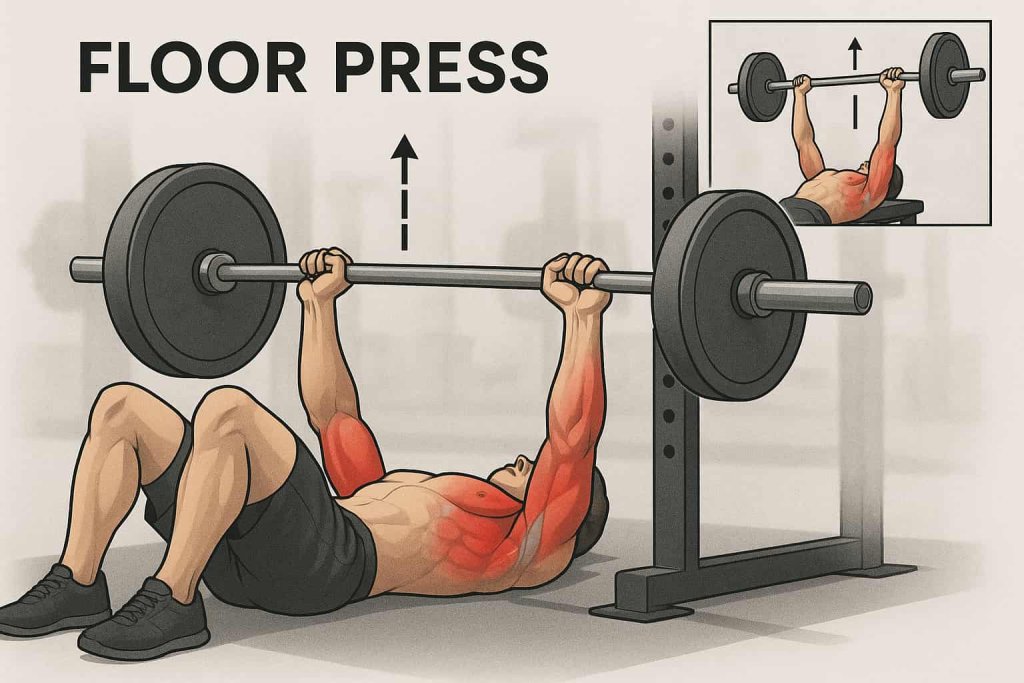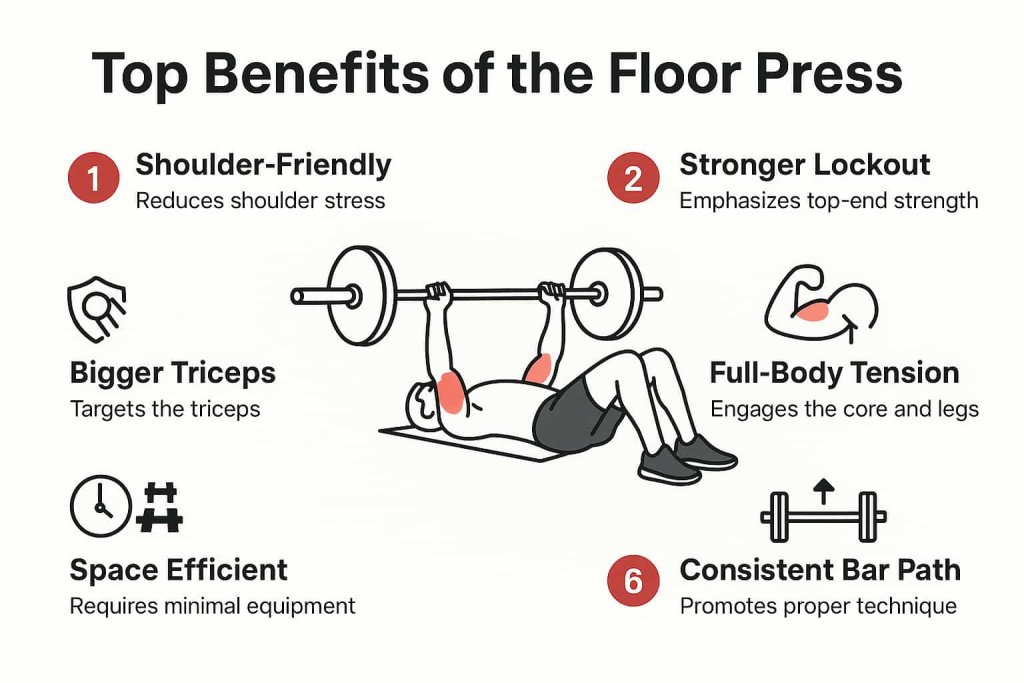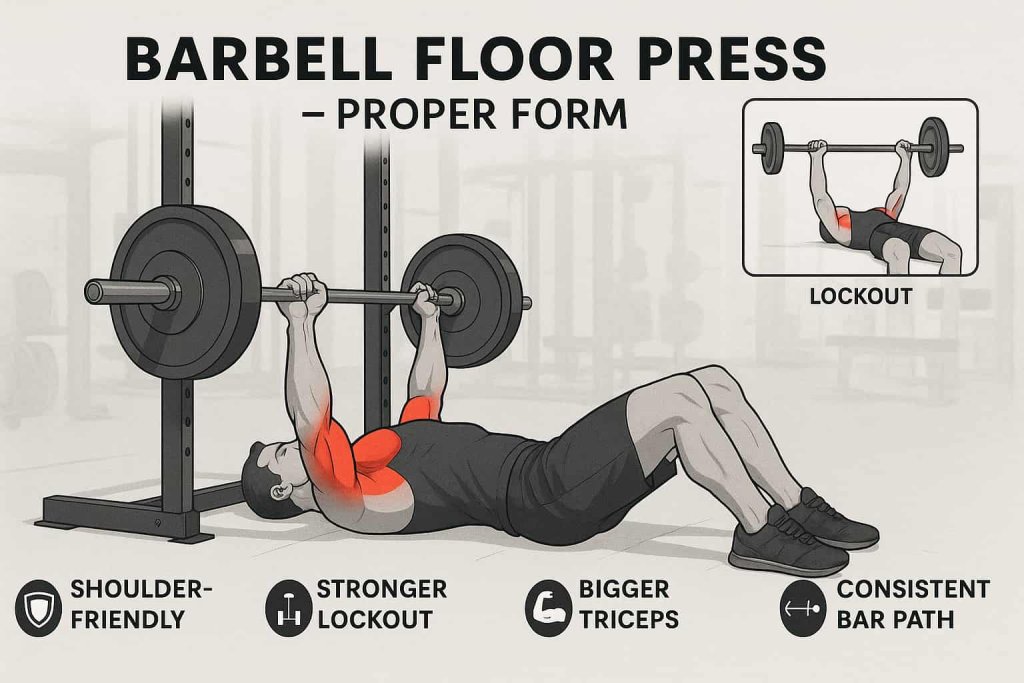Yes — the floor press is one of the smartest upper-body strength training exercises you can add to your routine, delivering bigger triceps, a stronger bench press, and healthier shoulders.
By performing a press while lying flat on the floor, you limit the range of motion (ROM) and target the lockout portion of the lift — the exact point where many lifters fail. This makes the floor press a powerful tool for boosting triceps strength, protecting your shoulder joints, and smashing through bench press plateaus.

Understanding how and why the floor press works will help you program it effectively — whether your goal is raw pressing power, muscle growth, or injury-free training.
What Is the Floor Press?
The floor press is a barbell or dumbbell pressing variation performed while lying flat on your back on the floor instead of a bench. Your elbows lower until they touch the ground, which:
- Reduces the bottom stretch compared to a bench press
- Eliminates leg drive (unless slightly bracing for stability)
- Forces the triceps and upper chest to do more work in the top half of the press
Muscles Worked:
- Primary: Triceps brachii, pectoralis major (upper/mid chest), anterior deltoids
- Secondary: Lats, core, forearms (stabilization)
Top Benefits of the Floor Press

1. Shoulder-Friendly Pressing
- The shortened ROM means less strain on the rotator cuff and anterior deltoids.
- Especially useful for lifters recovering from shoulder pain or those with mobility restrictions.
- Allows pressing heavy without aggravating old injuries.
Pro Tip: If deep bench pressing causes shoulder discomfort, rotate in floor presses for 4–6 weeks.
2. Improves Bench Press Lockout Strength
- Focuses on the sticking point in the upper half of the press.
- Overloading this segment translates directly to a stronger bench press 1RM.
- Frequently used in powerlifting programs to boost top-end pressing power.
3. Builds Bigger, Stronger Triceps
- Triceps are the main movers once the elbows pass 90 degrees.
- More triceps strength = better performance in all pressing lifts (bench, overhead press, dips).
- Excellent for both hypertrophy and strength gains.
4. Teaches Full-Body Tension
Even without a bench, you must:
- Engage your lats to control the bar path
- Brace your core for stability
- Maintain controlled wrist and elbow alignment
This skill improves bench press form and overall pressing efficiency.
5. Time & Space Efficient
- Requires minimal setup — just a floor space and a barbell or dumbbells.
- Ideal for home gyms, crowded commercial gyms, or travel workouts.
- Can be done without a spotter if performed inside safety pins of a power rack.
6. Improves Bar Path Consistency
- The floor acts as a physical stopping point, helping you practice lowering the bar to the same depth each time.
- Reduces bad habits like over-stretching or losing shoulder retraction.
How to Perform the Floor Press (Barbell Version)

- Setup
- Lie flat on the floor inside a power rack.
- Barbell should be racked just above chest height.
- Keep feet either flat on the floor or legs extended.
- Grip
- Slightly wider than shoulder-width (standard bench grip).
- Unrack
- Brace your core, retract your shoulder blades, and lift the bar out of the rack.
- Lower
- Control the descent until your triceps gently touch the floor — no bouncing.
- Pause
- Brief pause for 1–2 seconds to eliminate momentum.
- Press
- Drive the bar upward until elbows lock out.
- Repeat
- 3–5 sets of 3–6 reps for strength, or 8–12 reps for muscle growth.
Popular Floor Press Variations
1. Dumbbell Floor Press
The dumbbell floor press allows for greater range of motion control compared to a barbell, as each arm moves independently.
Why it works: Using dumbbells ensures each arm carries its fair share of the load, preventing one side from compensating for the other. The independent handles also allow for a neutral grip, which can reduce shoulder strain.
How to do it:
- Lie on your back with knees bent, feet flat.
- Hold a dumbbell in each hand above your chest with arms extended.
- Lower the weights until your upper arms touch the floor.
- Pause briefly, then press back to the start.
Pro tip: Avoid bouncing your arms off the floor—keep the movement controlled for maximum muscle engagement.
2. Close-Grip Floor Press
This version emphasizes the triceps by reducing elbow flare and narrowing the grip.
Why it works: Bringing your hands closer together decreases chest involvement and shifts the workload onto the triceps, especially in the lockout phase.
How to do it:
- Lie flat and grip the barbell or dumbbells shoulder-width or narrower.
- Keep elbows tucked close to your torso.
- Lower slowly until upper arms touch the ground.
- Drive up, focusing on squeezing the triceps.
Pro tip: Use this as a finisher after heavy chest work to blast triceps without heavy shoulder strain.
3. Floor Press with Chains or Bands
Adding chains or resistance bands changes the strength curve by making the top portion of the lift heavier.
Why it works: This overloads the lockout phase, a common weak point for many lifters, and builds explosive pressing strength.
How to do it:
- Attach bands to the barbell anchored to the floor or load chains evenly on both ends.
- Perform the floor press normally, noting that resistance will increase as you press upward.
Pro tip: Keep control through the entire movement—don’t let the added resistance snap the bar down on the descent.
4. Single-Arm Floor Press
A unilateral version that also challenges core stability.
Why it works: Pressing with one arm forces your obliques and deep core muscles to work overtime to keep your torso from rotating. It’s great for fixing imbalances and building shoulder stability.
How to do it:
- Lie flat holding one dumbbell above your chest.
- Keep your free hand on your hip or extended for balance.
- Lower slowly until your upper arm taps the floor.
- Press back up, resisting any torso twist.
Pro tip: Use lighter weight than you would for bilateral presses—form and stability are the priorities here.
Common Mistakes to Avoid
- Bouncing off the floor – Removes tension and risks elbow injury.
- Flaring elbows – Increases shoulder stress.
- Rushing reps – Use controlled tempo for better muscle activation.
- Neglecting warm-up – Cold shoulders = higher injury risk.
Programming Tips
- Strength Focus: 3–5 reps × 4–6 sets @ 80–90% 1RM
- Hypertrophy Focus: 8–15 reps × 3–4 sets, slow eccentric
- Accessory Work: Place after main bench press sets for triceps overload
Weekly Frequency: 1–2 times per week is enough for most lifters.
FAQs
1. Is the floor press better than the bench press?
No — it’s a supplemental lift. Use both for maximum results.
2. Does it work the chest as much?
Not as much stretch as bench press, but still activates upper/mid chest.
3. Can I use it for rehab?
Yes, but get clearance from your physio first.
4. How heavy should I go?
Similar or slightly less than your bench press due to lack of leg drive.
5. What’s the best grip width?
Standard bench press grip or slightly narrower for triceps focus.
6. Can I do it without a rack?
Yes — use dumbbells for safety if no rack is available.
7. How does it help powerlifters?
Directly strengthens the top half of the bench press.
Conclusion
The floor press is more than a bench press alternative — it’s a strategic tool for stronger lockouts, bigger triceps, and healthier shoulders. Whether you’re a beginner looking for safe pressing or a powerlifter chasing a new PR, adding floor presses to your program will pay off in strength and size.
